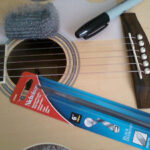Learning Scales
Learning how to play the minor pentatonic scales is a great way to learn lead guitar and solos. Memorizing them may seem a bit difficult at first but I’ll try to break it down to you in a way that is easy to understand. If you look at picture two at the top of this article you will see the E minor pentatonic scale that starts on the 12th fret. Most websites write it out that way and it is just a bunch of colors and numbers going across the neck, when I started out I had no idea what the heck any of that meant, so I decided to break it all down in this article to hopefully make this lesson easy to understand without you having to learn a bunch of Music theory. Before we get started take a look here: Guitar Scales.
If you click on the link you will see that the first scale I teach in that lesson is the E minor pentatonic scale, which is the exact same scale I will be teaching in this article. The only differences between the E minor scale in this article and the one from the previous article is that the scale was moved up to the 12th fret of the guitar’s neck. All of the notes are exactly the same. In the scale pictures that I provided I didn’t include the other neck positions for each scale because I didn’t want to confuse you with all the different colors and numbers, and to keep the lesson simple I only show that one position.
If you know which notes to play you can play the same scale at different places on the neck to get a different sound, finding them isn’t hard after you know what to look for. Both the E minor pentatonic scale in this article and the previous article consist of the notes: E, G, A, B, D, and then it repeats back to E.
A little bit confusing? I’ll try to explain it a bit easier. Take a look at the below TAB:
E Minor Pentatonic scale
E|–12—15———————-|————————————|
B|————12—15———–|————————————|
G|———————-12—14-|————————————|
D|———————————|-12—14————————-|
A|———————————|————-12—14————-|
E|———————————|————————12—15–|
The root note for this scale is E, so every note that is bold and underlined shows you the root note, that is what gives it the E minor sound. When you play lead guitar solos you want to start and finish your solos with that note so that it stands out from all the other notes. I often add a bit of vibrato to the note as well to make it sound a bit more distinct. Now that you understand that the root note gives the scales their sound, let’s go back to picture two and make it a bit easier to understand. Let’s arrange all of the notes in my TAB to look exactly like picture two so that you get this:
E|–12———–15—–|
B|-12———–15—–|
G|-12—14————-|
D|-12—14————-|
A|-12—14————|
E|–12———–15—-|
Now they look the same, right? So when you go to other websites and they show the colorful number diagram, just find the root note within their box shape and then play the scale. I’ll go in more detail about scales in another article and tell you how to turn them into awesome guitar solos, but for now just take a look at the rest of the scales and memorize their sound and finger positions.
C Minor Pentatonic scale
E|——8————————|———————————–|
B|————11—8————|———————————–|
G|———————-10—8–|———————————–|
D|———————————|-10—8————————-|
A|———————————|————-10—8————-|
E|———————————|———————–11—8—|
E|–8——————–|
B|-8———–11——|
G|-8—10————-|
D|-8—10————-|
A|-8—10————-|
E|–8————11—-|
D Minor Pentatonic scale
E|——10————————|———————————–|
B|————13—10————|———————————–|
G|———————-12—10–|———————————–|
D|———————————|-12—10————————-|
A|———————————|————-12–10————–|
E|———————————|———————–13—10—|
E|–10——————–|
B|-10———–13——|
G|-10—12————-|
D|-10—12————-|
A|-10—12————-|
E|–10————13—-|
G Minor Pentatonic scale
E|——3———————–|———————————|
B|————6—3————|———————————|
G|———————-5—3–|———————————|
D|——————————-|-5—3————————-|
A|——————————-|————-5–3————–|
E|——————————-|———————–6—3—|
E|—3——————-|
B|–3———–6——|
G|--3—5————-|
D|–3—5————-|
A|–3—5————-|
E|—3————6—-|
After you learn all the notes in a scale you can start to figure out where the scales can be moved around on the guitar neck to get different sounds. Most of the shapes stay the same in terms of where the root note is located. Notice how all the root notes lands on the middle, top and bottom frets? If you memorize one guitar scale you can figure out the shape for all of the other scales as well.
I also recommend that you try to play all of the above scales in position so that all of your fingers get an equal work out, that way you can later learn how to play guitar solos at lightning fast speed.




